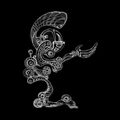Template:Selected anniversaries/July 25: Difference between revisions
No edit summary |
No edit summary |
||
| Line 19: | Line 19: | ||
File:Dominique Jean Larrey.jpg|link=Dominique Jean Larrey (nonfiction)|1842: Physician and surgeon [[Dominique Jean Larrey (nonfiction)|Dominique Jean Larrey]] dies. He was an important innovator in battlefield medicine and triage, and is often considered the first modern military surgeon. | File:Dominique Jean Larrey.jpg|link=Dominique Jean Larrey (nonfiction)|1842: Physician and surgeon [[Dominique Jean Larrey (nonfiction)|Dominique Jean Larrey]] dies. He was an important innovator in battlefield medicine and triage, and is often considered the first modern military surgeon. | ||
||1842: Daniel Paul Schreber born ... judge who suffered from what was then diagnosed as dementia praecox (later known as paranoid schizophrenia or schizophrenia, paranoid type). Though Schreber's book was made famous because of its value as a psychological memoir, the reason Schreber wrote the book was not for reasons of psychology. Schreber's purpose was expressed in its subtitle (which was not translated as part of the English edition, but fully reproduced inside it): "In what circumstance can a person deemed insane be detained in an asylum against his declared will?" Schreber, an accomplished jurist, wrote these memoirs in order to pose a legal question, namely, to what extent is it legitimate to keep someone like himself in an asylum when he expressly declares he desires his liberty. Pic. | |||
||1843: Charles Macintosh dies ... chemist and engineer. Pic. | ||1843: Charles Macintosh dies ... chemist and engineer. Pic. | ||
Revision as of 08:55, 3 April 2019
1616: Physician, alchemist and chemist Andreas Libavius dies. He accepted the Paracelsian principle of using occult properties to explain phenomena with no apparent cause, but rejected the conclusion that a thing possessing these properties must have an astral connection to the divine.
1617: Astronomer, mathematician, and crime-fighter Paul Guldin uses the Guldinus theorem to track down and apprehend math criminals.
1748: Astronomer Charles Messier's interest in astronomy is stimulated by an annular solar eclipse visible from his hometown.
1808: Mathematician Johann Benedict Listing born. He will introduce the term "topology" in a famous article published in 1847, having already used the term in correspondence some years earlier.
1836: New steganographic analysis of famed illustration Niles Cartouchian and Egon Rhodomunde Confront Gnotilus reveals several terabytes of encrypted data.
1837: The first commercial use of an electrical telegraph is successfully demonstrated in London by William Cooke and Charles Wheatstone.
1842: Physician and surgeon Dominique Jean Larrey dies. He was an important innovator in battlefield medicine and triage, and is often considered the first modern military surgeon.
1864: The well-known illustration Asclepius Myrmidon Prepares for Emergency Field Surgery "is a reasonably accurate depiction of events as I experienced them," Judge Havelock tells interviewer.
1920: Chemist and X-ray crystallographer Rosalind Franklin born. She will make contributions to the discovery of the molecular structure of DNA (deoxyribonucleic acid).
1963: Mathematician and physicist Nicholas Metropolis publishes new class of Gnomon algorithm functions which he derived using the Monte Carlo method. He will soon use these new functions to detect and prevent crimes against mathematical constants.
2016: Signed first edition of Lend a Hand used in high-energy literature experiment unexpectedly generates "at least a dozen, perhaps as many as fifteen" organic golems.
2017: Dennis Paulson of Mars observes a minute of silence in memory of the Viking 2 orbiter, which was turned off forty-one years ago, after returning almost 16,000 images in about 700–706 orbits around Mars.












